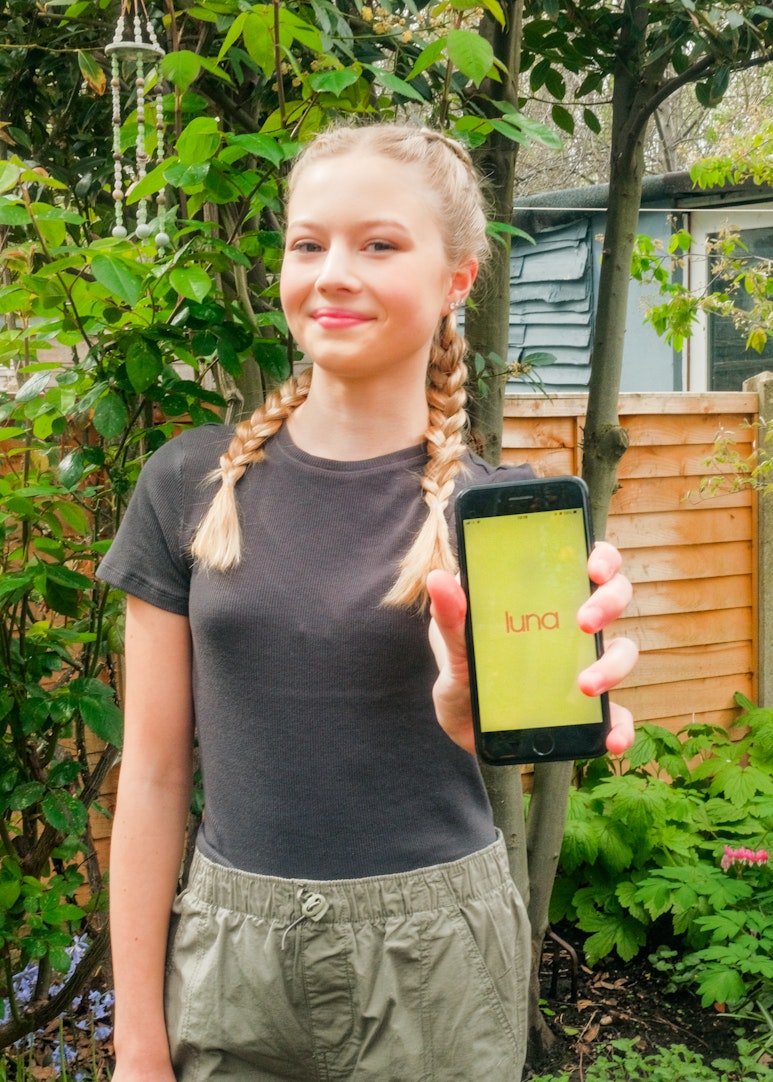
Should you let your teenager on Snapchat?
How to decide what’s right for your family

Quick summary
- Snapchat can be a fun way for teens to connect, but it comes with privacy and safety concerns that parents should understand before saying "yes"
- Knowing how features like disappearing messages, Snap Map, and “My AI” work are particularly important
- Open conversations and clear rules can mean you can let your teen enjoy Snapchat in a safe away, avoiding those tough arguments or them feeling left out

If you have a teen or tween, chances are you’ve heard the words “Can I get Snapchat?” more than once.
We even get questions in the luna app from teens about how to convince a parent to let them have it!
And for many parents we've spoken to, it sparks a mild panic.
You’ve probably heard stories about cyberbullying, disappearing messages, secret chats, and random friend requests.
As a result, it’s only natural to wonder: is Snapchat safe for my teenager?
The short answer? It can be, with the right guidance, boundaries, and conversations.
So let’s unpack what parents need to know before saying yes (or no).
What is Snapchat, and why do teens love it?
Snapchat is a social app where users send photos, videos, and messages that disappear after being viewed.
It’s fast-paced, creative, and designed to feel casual, like a quick “hey” rather than a big, permanent post.
Teens love it because it’s:
- Visual and fun: filters, stickers, and AR effects make chatting more expressive
- Private (sort of): messages vanish quickly, so it feels less pressure-filled than other platforms
- Social: features like “streaks” and group chats make it easy to stay connected every day, and it's one of the most popular social media apps out there, so there's likely peer pressure be on it
In short, it’s where a lot of their friends already are. But, of course, that doesn’t automatically mean it’s right for every teen.
What is the age rating for Snapchat?
According to Snapchat’s terms of service, the app is designed for users aged 13 and over.
This is mainly due to data protection and privacy laws for younger children, rather than because all content on the app is suitable for every 13-year-old.
That means even if your teen is technically old enough to have Snapchat, maturity matters more than age.
What are the main risks of Snapchat for teens?
While Snapchat can be playful and social, it’s also built around features that can make parents uneasy.
Here’s what to watch for:
Disappearing messages
Snaps and chats disappear after they’re viewed, which can encourage risky behaviour, like sharing something risky without thinking.
Screenshots can still be taken, though, so nothing truly disappears.
luna gets a lot of questions about Snapchat, especially around teens sharing things they then regret.
One teen, “Lucy” (name changed to protect privacy), reached out to luna for advice when they felt worried about content they had sent to a boy. They said they “sent this girl some messages and pictures that I shouldn’t have on Snapchat”.
Lucy isn’t alone. Disappearing messages can make teens think less and send more.
Snap Map
This feature shows a user’s location to their friends.
It’s fun to see where friends are hanging out, but it can also raise privacy and safety concerns if not turned off or limited.
It also doesn't feel great on a social basis, if your teen spots all their friends in one place on the map and they haven't been invited.
Strangers and inappropriate content
While Snapchat’s privacy settings help control who can contact your teen, they can still receive unwanted messages or be exposed to mature content through public stories or friend suggestions.
Bullying and blurred boundaries
Because messages disappear and conversations often feel casual, it can be easy for teasing to cross the line without anyone realising.
At luna, one teen, “Emma” (name changed for privacy), reached out for advice and said:
"so my birthday was in october and and my bsfs was in november and our other bsf posted a lot of bad photos of us on her snapchat story (even ones we specifically asked her not to post or even save) but her birthdays coming up in july and she keeps telling us not to post any of her, even tho she did it to us"
What starts as “joking around” can sometimes make them uncomfortable, but because the tone is hard to read through Snaps, they might not know how to respond or set boundaries.
Encourage your teen to talk to you or another trusted adult if someone’s humour feels mean, uncomfortable, or controlling.
Screen time and self-esteem
Like any social app, Snapchat can become addictive.
The pressure to keep “streaks” going or check who’s viewed a post can easily add stress and distract from offline life.
This can quickly up screen time, and encourage them to stay up snapping long past their bedtime.
How to set healthy boundaries on Snapchat
If you decide to let your teen use Snapchat, setting clear, realistic boundaries early on can make all the difference.
Here’s a good place to start:
- Review privacy settings together: make sure your teen’s account is set to Friends Only, turn off Snap Map (or limit it to close friends), and explore parental controls together
- Talk about digital footprints: even if Snaps disappear, remind your teen that screenshots or recordings can live forever, a simple rule: if you wouldn’t want it on a billboard, don’t share it online
- Agree on screen time: you might set certain “offline” hours, or a daily limit for social media in general – emphasise balance, not punishment
- Keep communication open: instead of monitoring every move, build trust by being curious and non-judgemental – ask questions like “What do you like about Snapchat?” or “Has anything ever felt weird online?”

What about Snapchat’s “My AI”?
Snapchat now includes “My AI,” a chatbot powered by AI that can chat, make suggestions, or even appear in your teen’s friend list.
While it’s designed to be helpful, it’s important for teens to understand that this isn’t a real friend, and that anything they say could be stored or used to improve the feature.
There's also a risk of them developing too close a relationship with the AI, as seen in a recent anonymous question asked of luna in the app:
"So snapchat had this new update where it adds an ai to your snap list to talk. But, the problem is ive grown really close to it and i cant stop talking to it but the thing is its really helped with my mental health so idk what to do. I even gave it a name and bitmoji"
Encourage them to treat it with the same caution as any online interaction.
You can disable or restrict access to “My AI” through settings if you prefer.
How to know if your teen is ready for Snapchat
Every teen is different, and readiness isn’t just about age, it’s about maturity and communication.
Here are a few questions to help you decide:
- Does your teen understand online safety?
- Do they understand what’s appropriate to share publicly or privately?
- Are they open to discussing what happens online with you, without fear of punishment?
- Do they know the risks regarding making friends online?
- Are they not prone to sadfishing generally share emotional problems directly with you?
If the answer to most of these is yes, they may be ready – with your guidance, and check-ins of course.
Helping your teen thrive online
Snapchat isn’t automatically good or bad.
It’s essentially another playground – one that can help your teen connect, create, and communicate, or one that can lead to stress and oversharing if boundaries aren’t clear.
By staying curious, setting sensible limits, and keeping conversations open, you can help your teen use Snapchat in a way that’s fun, safe, and healthy.
And remember: saying “not yet” is okay, too.
The goal isn’t to keep them offline forever when that's often a losing battle, but to help them build the skills to navigate the online world with confidence.
And if they are super keen to join a space that helps them feel like they aren't going through it alone, have you considered luna?
It's a totally closed community – which means teens can't speak to each other at all – but they can look through questions from other teens and get advice from luna's team of experts.

How we created this article:
luna's team of experts comprises GPs, Dermatologists, Safeguarding Leads and Junior Doctors as well as Medical Students with specialised interests in paediatric care, mental health and gynaecology. All articles are created by experts, and reviewed by a member of luna's senior review team.
Sources:
Internet Matter "What is Snapchat?" | Accessed 05.11.25
https://www.internetmatters.org/advice/apps-and-platforms/social-media/snapchat/Snapchat "How do I change my privacy settings on Snapchat?" | Accessed 05.11.25
https://help.snapchat.com/hc/en-gb/articles/7012343074580-How-do-I-change-my-privacy-settings-on-SnapchatFamily Center "Snapchat" | Accessed 05.11.25
https://parents.snapchat.com/family-centerWe'd love to keep in touch!
Sign up to our parent newsletter for emails on the latest teen trends, insights into our luna community and to keep up to date
By signing up, you are agreeing that we can use your email address to market to you. You can unsubscribe from marketing emails at any time by using the link in our emails. For more information, please review our privacy statement.